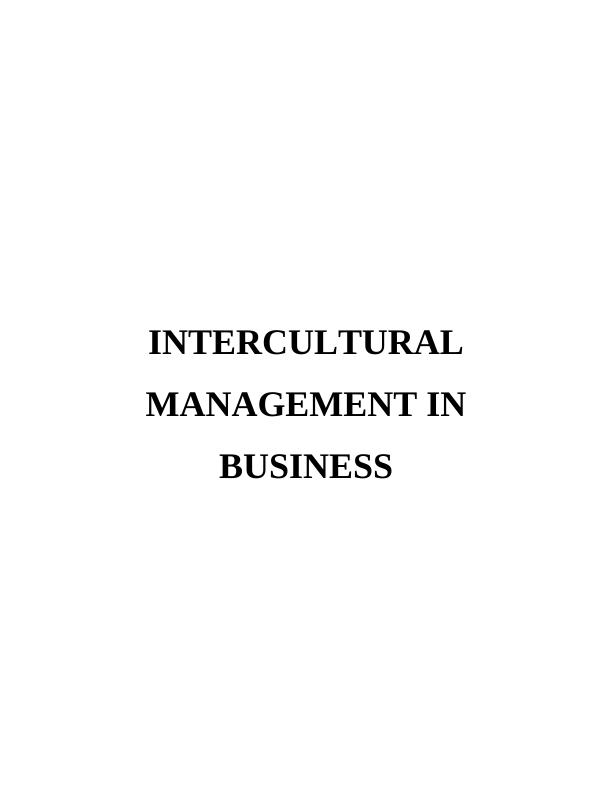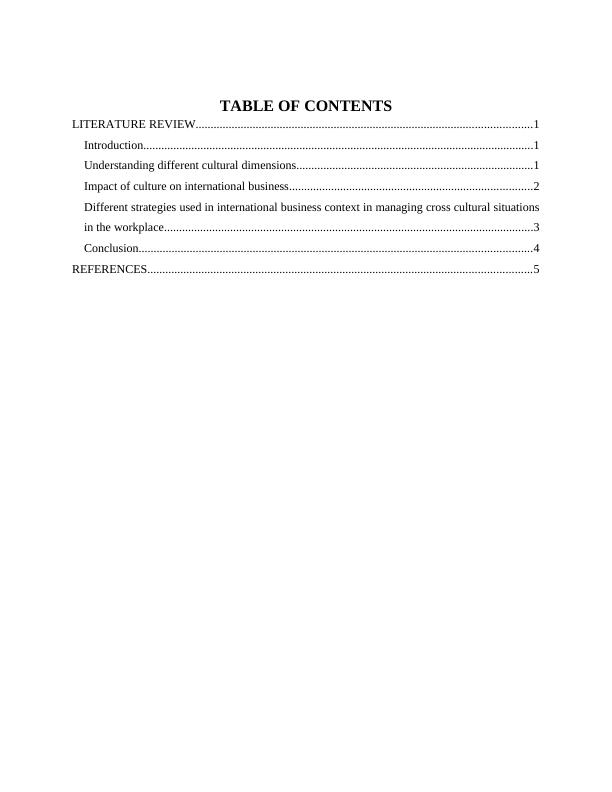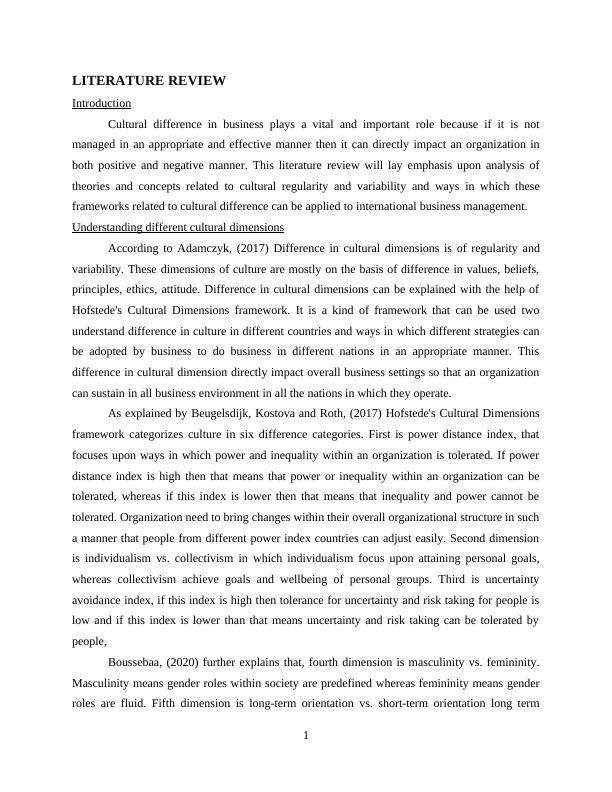Intercultural Management in Business
Added on 2023-01-04
7 Pages1969 Words4 Views
INTERCULTURAL
MANAGEMENT IN
BUSINESS
MANAGEMENT IN
BUSINESS

TABLE OF CONTENTS
LITERATURE REVIEW................................................................................................................1
Introduction..................................................................................................................................1
Understanding different cultural dimensions...............................................................................1
Impact of culture on international business.................................................................................2
Different strategies used in international business context in managing cross cultural situations
in the workplace...........................................................................................................................3
Conclusion...................................................................................................................................4
REFERENCES................................................................................................................................5
LITERATURE REVIEW................................................................................................................1
Introduction..................................................................................................................................1
Understanding different cultural dimensions...............................................................................1
Impact of culture on international business.................................................................................2
Different strategies used in international business context in managing cross cultural situations
in the workplace...........................................................................................................................3
Conclusion...................................................................................................................................4
REFERENCES................................................................................................................................5

LITERATURE REVIEW
Introduction
Cultural difference in business plays a vital and important role because if it is not
managed in an appropriate and effective manner then it can directly impact an organization in
both positive and negative manner. This literature review will lay emphasis upon analysis of
theories and concepts related to cultural regularity and variability and ways in which these
frameworks related to cultural difference can be applied to international business management.
Understanding different cultural dimensions
According to Adamczyk, (2017) Difference in cultural dimensions is of regularity and
variability. These dimensions of culture are mostly on the basis of difference in values, beliefs,
principles, ethics, attitude. Difference in cultural dimensions can be explained with the help of
Hofstede's Cultural Dimensions framework. It is a kind of framework that can be used two
understand difference in culture in different countries and ways in which different strategies can
be adopted by business to do business in different nations in an appropriate manner. This
difference in cultural dimension directly impact overall business settings so that an organization
can sustain in all business environment in all the nations in which they operate.
As explained by Beugelsdijk, Kostova and Roth, (2017) Hofstede's Cultural Dimensions
framework categorizes culture in six difference categories. First is power distance index, that
focuses upon ways in which power and inequality within an organization is tolerated. If power
distance index is high then that means that power or inequality within an organization can be
tolerated, whereas if this index is lower then that means that inequality and power cannot be
tolerated. Organization need to bring changes within their overall organizational structure in such
a manner that people from different power index countries can adjust easily. Second dimension
is individualism vs. collectivism in which individualism focus upon attaining personal goals,
whereas collectivism achieve goals and wellbeing of personal groups. Third is uncertainty
avoidance index, if this index is high then tolerance for uncertainty and risk taking for people is
low and if this index is lower than that means uncertainty and risk taking can be tolerated by
people,
Boussebaa, (2020) further explains that, fourth dimension is masculinity vs. femininity.
Masculinity means gender roles within society are predefined whereas femininity means gender
roles are fluid. Fifth dimension is long-term orientation vs. short-term orientation long term
1
Introduction
Cultural difference in business plays a vital and important role because if it is not
managed in an appropriate and effective manner then it can directly impact an organization in
both positive and negative manner. This literature review will lay emphasis upon analysis of
theories and concepts related to cultural regularity and variability and ways in which these
frameworks related to cultural difference can be applied to international business management.
Understanding different cultural dimensions
According to Adamczyk, (2017) Difference in cultural dimensions is of regularity and
variability. These dimensions of culture are mostly on the basis of difference in values, beliefs,
principles, ethics, attitude. Difference in cultural dimensions can be explained with the help of
Hofstede's Cultural Dimensions framework. It is a kind of framework that can be used two
understand difference in culture in different countries and ways in which different strategies can
be adopted by business to do business in different nations in an appropriate manner. This
difference in cultural dimension directly impact overall business settings so that an organization
can sustain in all business environment in all the nations in which they operate.
As explained by Beugelsdijk, Kostova and Roth, (2017) Hofstede's Cultural Dimensions
framework categorizes culture in six difference categories. First is power distance index, that
focuses upon ways in which power and inequality within an organization is tolerated. If power
distance index is high then that means that power or inequality within an organization can be
tolerated, whereas if this index is lower then that means that inequality and power cannot be
tolerated. Organization need to bring changes within their overall organizational structure in such
a manner that people from different power index countries can adjust easily. Second dimension
is individualism vs. collectivism in which individualism focus upon attaining personal goals,
whereas collectivism achieve goals and wellbeing of personal groups. Third is uncertainty
avoidance index, if this index is high then tolerance for uncertainty and risk taking for people is
low and if this index is lower than that means uncertainty and risk taking can be tolerated by
people,
Boussebaa, (2020) further explains that, fourth dimension is masculinity vs. femininity.
Masculinity means gender roles within society are predefined whereas femininity means gender
roles are fluid. Fifth dimension is long-term orientation vs. short-term orientation long term
1

End of preview
Want to access all the pages? Upload your documents or become a member.
Related Documents
Study Skills for Higher Education- Doclg...
|6
|1309
|239
UK Cultural Autobiography: Understanding the Differences and Similarities between UK and Arabic Culturelg...
|10
|2777
|494
Intercultural Competence Assignment Reportlg...
|12
|802
|33
Analysis of Study Skillslg...
|6
|1292
|81
Hofstede's Cultural Dimension Framework: A Critical Evaluationlg...
|7
|1316
|33
When we talk about the cultural aspectlg...
|7
|1208
|18
